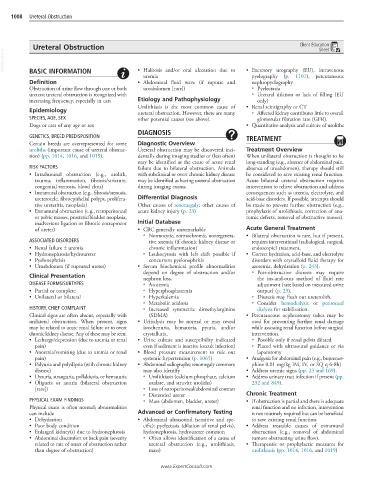Page 2015 - Cote clinical veterinary advisor dogs and cats 4th
P. 2015
1008 Ureteral Obstruction
Ureteral Obstruction Client Education
Sheet
VetBooks.ir
• Halitosis and/or oral ulceration due to
BASIC INFORMATION
uremia • Excretory urography (EU), intravenous
pyelography (p. 1101), percutaneous
Definition • Abdominal fluid wave (if rupture and nephropyelography
Obstruction of urine flow through one or both uroabdomen [rare]) ○ Pyelectasia
ureters; ureteral obstruction is recognized with ○ Ureteral dilation or lack of filling (EU
increasing frequency, especially in cats Etiology and Pathophysiology only)
Urolithiasis is the most common cause of • Renal scintigraphy or CT
Epidemiology ureteral obstruction. However, there are many ○ Affected kidney contributes little to overall
SPECIES, AGE, SEX other potential causes (see above). glomerular filtration rate (GFR).
Dogs or cats of any age or sex • Quantitative analysis and culture of uroliths
DIAGNOSIS
GENETICS, BREED PREDISPOSITION TREATMENT
Certain breeds are overrepresented for some Diagnostic Overview
uroliths (important cause of ureteral obstruc- Ureteral obstruction may be discovered inci- Treatment Overview
tion) (pp. 1014, 1016, and 1019). dentally during imaging studies or (less often) When unilateral obstruction is thought to be
may be identified as the cause of acute renal long-standing (e.g., absence of abdominal pain,
RISK FACTORS failure due to bilateral obstruction. Animals absence of uroabdomen), therapy should still
• Intraluminal obstruction (e.g., urolith, with subclinical or overt chronic kidney disease be considered to save existing renal function.
trauma, inflammation, fibrosis/stricture, may be identified as having ureteral obstruction Acute bilateral ureteral obstruction requires
congenital stenosis, blood clots) during imaging exams. intervention to relieve obstruction and address
• Intramural obstruction (e.g., fibrosis/stenosis, consequences such as uremia, electrolyte, and
ureterocele, fibroepithelial polyps, prolifera- Differential Diagnosis acid-base disorders. If possible, attempts should
tive ureteritis, neoplasia) Other causes of renomegaly; other causes of be made to prevent further obstruction (e.g.,
• Extramural obstruction (e.g., retroperitoneal acute kidney injury (p. 23) prophylaxis of urolithiasis, correction of ana-
or pelvic masses, prostatic/bladder neoplasia, tomic defects, removal of obstructive masses).
inadvertent ligation or fibrotic entrapment Initial Database
of ureter) • CBC generally unremarkable Acute General Treatment
○ Normocytic, normochromic, nonregenera- • Bilateral obstruction is rare, but if present,
ASSOCIATED DISORDERS tive anemia (if chronic kidney disease or requires interventional (radiological, surgical,
• Renal failure ± uremia chronic inflammation) endoscopic) treatment.
• Hydronephrosis/hydroureter ○ Leukocytosis with left shift possible if • Correct hydration, acid-base, and electrolyte
• Pyelonephritis concurrent pyelonephritis disorders with crystalloid fluid therapy for
• Uroabdomen (if ruptured ureter) • Serum biochemical profile abnormalities azotemia, dehydration (p. 243).
depend on degree of obstruction and/or ○ Post-obstructive diuresis may require
Clinical Presentation nephron loss. the ins-and-outs method of fluid rate
DISEASE FORMS/SUBTYPES ○ Azotemia adjustment (rate based on measured urine
• Partial or complete ○ Hyperphosphatemia output) (p. 23).
• Unilateral or bilateral ○ Hyperkalemia ○ Diuresis may flush out ureterolith.
○ Metabolic acidosis ○ Consider hemodialysis or peritoneal
HISTORY, CHIEF COMPLAINT ○ Increased symmetric dimethylarginine dialysis for stabilization.
Clinical signs are often absent, especially with (SDMA) • Percutaneous nephrostomy tubes may be
unilateral obstruction. When present, signs • Urinalysis may be normal or may reveal used for preventing further renal damage
may be related to acute renal failure or to overt isosthenuria, hematuria, pyuria, and/or while assessing renal function before surgical
chronic kidney disease. Any of these may be seen: crystalluria. intervention.
• Lethargy/depression (due to uremia or renal • Urine culture and susceptibility indicated ○ Possible only if renal pelvis dilated
pain) even if sediment is inactive (occult infection) ○ Placed with ultrasound guidance or via
• Anorexia/vomiting (due to uremia or renal • Blood pressure measurement to rule out laparotomy
pain) systemic hypertension (p. 1065) • Analgesia for abdominal pain (e.g., buprenor-
• Polyuria and polydipsia (with chronic kidney • Abdominal radiographs; renomegaly common; phine 0.01 mg/kg IM, IV, or SQ q 6-8h)
disease) may also identify • Address uremic signs (pp. 23 and 169).
• Dysuria, stranguria, pollakiuria, or hematuria ○ Urolithiasis (calcium phosphate, calcium • Address urinary tract infection if present (pp.
• Oliguria or anuria (bilateral obstruction oxalate, and struvite uroliths) 232 and 849).
[rare]) ○ Loss of retroperitoneal/abdominal contrast
○ Distended ureter Chronic Treatment
PHYSICAL EXAM FINDINGS ○ Mass (abdomen, bladder, ureter) • If obstruction is partial and there is adequate
Physical exam is often normal; abnormalities renal function and no infection, intervention
can include Advanced or Confirmatory Testing is not routinely required but can be beneficial
• Dehydration • Abdominal ultrasound (sensitive and spe- to save existing renal function.
• Poor body condition cific): pyelectasia (dilation of renal pelvis), • Address treatable causes of extramural
• Enlarged kidney(s) due to hydronephrosis hydronephrosis, hydroureter common obstruction (e.g., removal of abdominal
• Abdominal discomfort or back pain (severity ○ Often allows identification of a cause of tumors obstructing urine flow).
related to rate of onset of obstruction rather ureteral obstruction (e.g., urolithiasis, • Therapeutic or prophylactic measures for
than degree of obstruction) mass) urolithiasis (pp. 1014, 1016, and 1019)
www.ExpertConsult.com

